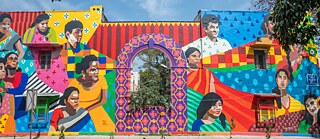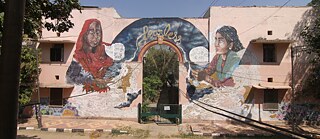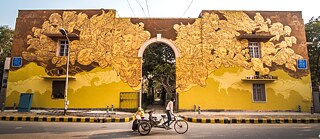Behind the Scenes
Lodhi Art District

Lodhi Colony is a government housing neighbourhood built during the British Raj in the 1940s. Designed by architect Walter Sykes George, the colony is known for being pedestrian-friendly, with its large sidewalks and abundant greenery – a rarity for the city of New Delhi.
In a city of high population density and a lack of public spaces that offer cultural experiences, St+art believed Lodhi Colony had immense potential to become an art district. Since 2016, St+art has been working in the neighbourhood, inviting Indian and international artists to paint large-scale murals over the Indo-European facades, bringing to life the first open-air art gallery in India.
Initiated during a time when the urban art scene was at a nascent stage in India, the art district has been a key agent in fostering recognition and building a community for itself. The idea since its inception has been to present a diverse range of genres that characterise the wide spectrum of styles and approaches within the global street art phenomena.
Thus, along with urban reinterpretation of realism, surrealism, abstract art, graffiti, and more, Lodhi has also a special localised focus on diminishing traditional Indian art forms—such as Gond, Sign Painting, and Shekawati. By showcasing such varied practises on a common platform, the art district enables cross-cultural exchange and bridges the gap between the old and the new.
Each artwork in its own specific way explores the narratives of the city, adopting relevant themes like women empowerment, trans inclusion, environment, and heritage conservation. The murals, therefore, serve also to stimulate our civic responsibilities and build values of inclusivity amongst otherwise-segregated communities.
Using the socio-economic dynamic as the primary input, local NGOs have tailored activities designed to enhance the community life in Lodhi. With the decade-old tailor shops donating their waste fabric for a workshop where women of Lodhi recycled them into products, this programming strives for inclusivity while creating a new/creative interface for the neighbourhood’s communities to interact.
Over the years, the district has been enriched by over 50 murals by some of the most worldwide recognised urban artists. Workshops and tours have integrated the community and the citizenship at large. The multidisciplinary artists such as dancers, musicians, and performers have made the district a cultural hub. And of course, Lodhi’s unique architecture and expansive territory have given these artists a unique interactive platform — where people from all walks of life, from diplomats to chai-wallas (tea sellers), can feel welcomed in the same space.
This open-air gallery is an ongoing project that aims at humanising the city by offering a democratic experience of art and activating an exchange of ideas through shared experiences. The Public-Private collaboration amongst Asian Paints, Local Government bodies, Embassies, Institutes of Culture has been bound by a long-term vision of building liveable and sustainable cities, which now contributes to the everyday life in Lodhi.
On 1st March 2019, Lodhi Art District was officially inaugurated as India’s first Art District by Shri Prabhakar Singh, Director General of CPWD.





